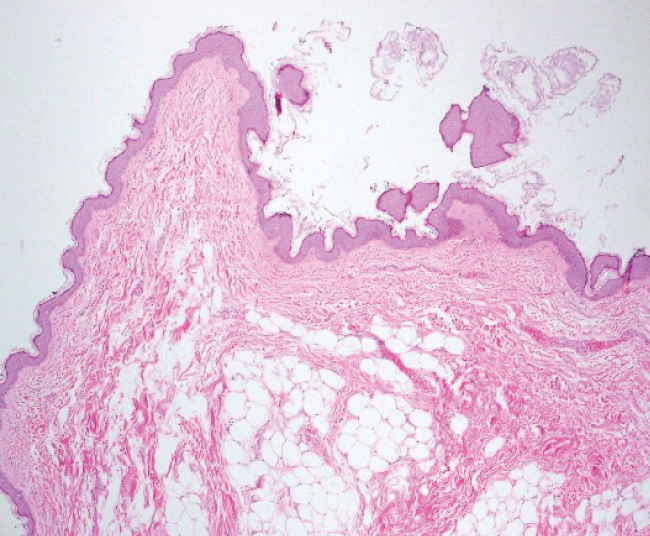International Journal of Pathology and Clinical Research
Reduced and Thinned Elastic Fibers in Skin Tag
Ahmed Abdullah Alhumidi*
Department of pathology, King Khalid university hospital, College of medicine, Saudi Arabia
*Corresponding author:
Ahmed Abdullah Alhumidi, Associate professor, and consultant of pathology and dermatopathology, Department of pathology, King Khalid university hospital, College of medicine, King Saud University, PO box 2925, Riyadh 11461, Saudi Arabia, Tel: 00966-4679265; E-mail: ahmedbgj@hotmail.com
Int J Pathol Clin Res, IJPCR-2-030, (Volume 2, Issue 1), Mini Review; ISSN: 2469-5807
Received: December 18, 2015 | Accepted: March 25, 2016 | Published: March 29, 2016
Citation: Alhumidi AA (2016) Reduced and Thinned Elastic Fibers in Skin Tag. Int J Pathol Clin Res 2:030. 10.23937/2469-5807/1510030
Copyright: © 2016 Alhumidi AA. This is an open-access article distributed under the terms of the Creative Commons Attribution License, which permits unrestricted use, distribution, and reproduction in any medium, provided the original author and source are credited.
Abstract
Objective: Skin tag (fibroepithelial polyp) is a benign skin lesion that is composed of a core of connective tissue and overlying epidermis with unknown etiology and pathogenesis. We conducted this study to demonstrate its relationship with elastic fiber abnormality.
Methods: We retrieved thirty histopathological cases of fibroepithelial polyps at king khalid University hospital, Riyadh, Saudi Arabia, during the period from 2010 to 2012. The cases were stained with elastic van Gieson stain.
Results: All the cases showed thinned dermal elastic fibers and twenty one revealed decrease in their count.
Conclusion: Fibroepithelial polyps show abnormal and/or decreased elastic fibers.
Introduction
Fibroepithelial polyp (skin tag) is a small soft benign cutaneous neoplasm. It has received little attention in the dermatological literature, because they have been regarded as being of little consequence. Its etiology and pathogenesis are controversial. Previous theories have suggested that a localized paucity of elastic tissue may result in sessile or atrophic lesions [1]. However, a more recent study of elastic tissue in fibroepithelial polyps showed no significant abnormalities [2].
Methodology
This is a retrospective study in which thirty histopathological specimens of fibroepithelial polyp (skin tag) were examined. Their paraffin blocks were collected from the archives of the Pathology Department, king khalid University hospital, Riyadh, Saudi Arabia, during the period from 2010 to 2012. Age of the patient, sex, and site, of the lesions as well as type of skin tag were recorded. Sections from each paraffin block were cut by a microtome at 5-micron thickness, stained with hematoxylin and eosin for histopathologic revision and with elastic-van Gieson stain for dermal elastic fiber evaluation. The number and thickness of elastic fibers were evaluated for each case as normal, reduced, or thinned. Normal adjacent skin was used as normal control.
Results
The mean age of patients was 44 years (range 26-66 years). There were 12 females and 18 males. The lesions were located most commonly on neck (n: 11) and thigh (n: 7) (Table 1). By Hematoxylin and eosin (H/E) stain, the lesion composed of a core of connective tissue covered by papillated epidermal surface (Figure 1). There were 17 furrowed, 7 bag-like and 6 filiform types. Elasticvan Gieson stain showed moderate to marked thinning of elastic fibers (EF) in all the cases as compared to normal control skin. Twenty one cases revealed reduced number of EF (Figure 2(A & B)).

.
Figure 1: Skin tag composed of papillary epidermis with underlying collagenous connective tissue (H/E original magnification X 100).
View Figure 1

.
Figure 2: Elastic Van Gieson stain shows marked decrease and thinning of elastic fibers (arrow) in skin tag. (A) as compared normal elastic fibers in adjacent dermis; (B) (elastic Van Gieson stain, original magnification X 200).
View Figure 2
![]()
Table 1: Clinical and pathological features of the cases.
View Table 1
Discussion
Fibroepithelial polyp (FEP) also called soft fibroma, acrochordon, and skin tag is a common benign cutaneous neoplasm. Clinically, they are soft, skin-colored, variably sized, pedunculated papules. The most common locations involved included, in decreasing order of frequency, the axilla, neck, groin, eyelid, abdomen, and back. No significant difference between genders was found [3]. In our cases, neck was the most common location and there was slight male predominance.
There are three types: furrowed papules, filiform lesions, and large bag-like protuberances. The histological features vary with the clinical type. The furrowed papules show epidermal hyperplasia and sometimes horn cyst formation. The filiform lesions are covered by an epidermis which shows only mild acanthosis. The larger, bag-like lesions usually have a stroma composed of loosely arranged collagen and a central core of adipose tissue [3].
There have been several reports suggesting an association between the presence of skin tags and underlying diabetes, abnormal lipid profile, colonic polyps, or acromegaly [4-6]. Its relation to elastic fiber abnormalities was controversial. Clinically, FEPs bare some resemblance to cutis laxa and pseudoxanthoma elasticum (PXE). All three conditions are characterized by skin-colored, soft lesions [7]. Furthermore, PXE characteristically affects some of the same sites as FEPs, including the neck and axilla. Because the etiology of PXE and cutis laxa is related to disorders of elastic tissue, one may theorize that FEPs are also caused by local abnormalities in elastic tissue. Old studies showed abnormal elastic tissue of in FEPs [1,8]. One recent study demonstrated that there were no significant abnormalities in elastic tissue in the FEPs [2]. Our study confirmed abnormality of elastic fibers of all cases of FEPs. All cases showed thinning of EFs as compared with adjacent normal dermis. Most of the cases revealed decreased number of dermal EFs.
Conclusion
Fibroepithelial polyp (skin tag) is a benign cutaneous neoplasm with unknown pathogenesis and controversial association with elastic fibers abnormality. Our study confirmed that thinned and reduced number of elastic fibers are strongly associated with FEPs.
References
-
Templeton HJ (1936) Cutaneous tags of the neck. Arch Dermatol 33: 495-505.
-
Adams BB, Mutasim DF (1999) Elastic tissue in fibroepithelial polyps. Am J Dermatopathol 21: 446-448.
-
Mark A. Hurt (2012) Weedon D. Weedon’s Skin Pathology. 3rd ed. London: Churchill Livingstone Elsevier, 2010. Dermatol Pract Conc 2: 79-82.
-
Beitler M, Eng A, Kilgour M, Lebwohl M (1986) Association between acrochordons and colonic polyps. J Am Acad Dermatol 14: 1042-1044.
-
Kahana M, Grossman E, Feinstein A, Ronnen M, Cohen M, et al. (1987) Skin tags: a cutaneous marker for diabetes mellitus. Acta Derm Venereol 67: 175-177.
-
Lawrence JH, Tobias CA, Linfoot JA, Born JL, Lyman JT, et al. (1970) Successful treatment of acromegaly: metabolic and clinical studies in 145 patients. J Clin Endocrinol Metab 31: 180-198.
-
Burton JL, Lovell CR (1998) Disorders of connective tissue. In: Champion RH, Burton JL, Burns DA, Breathnach SM, eds. Textbook of Dermatology. 6th ed. Malden, MA: Blackwell Science 2018-2026.
-
Mighell AJ, Robinson PA, Hume WJ (1997) Histochemical and immunohistochemical localisation of elastic system fibres in focal reactive overgrowths of oral mucosa. J Oral Pathol Med 26: 153-158.





